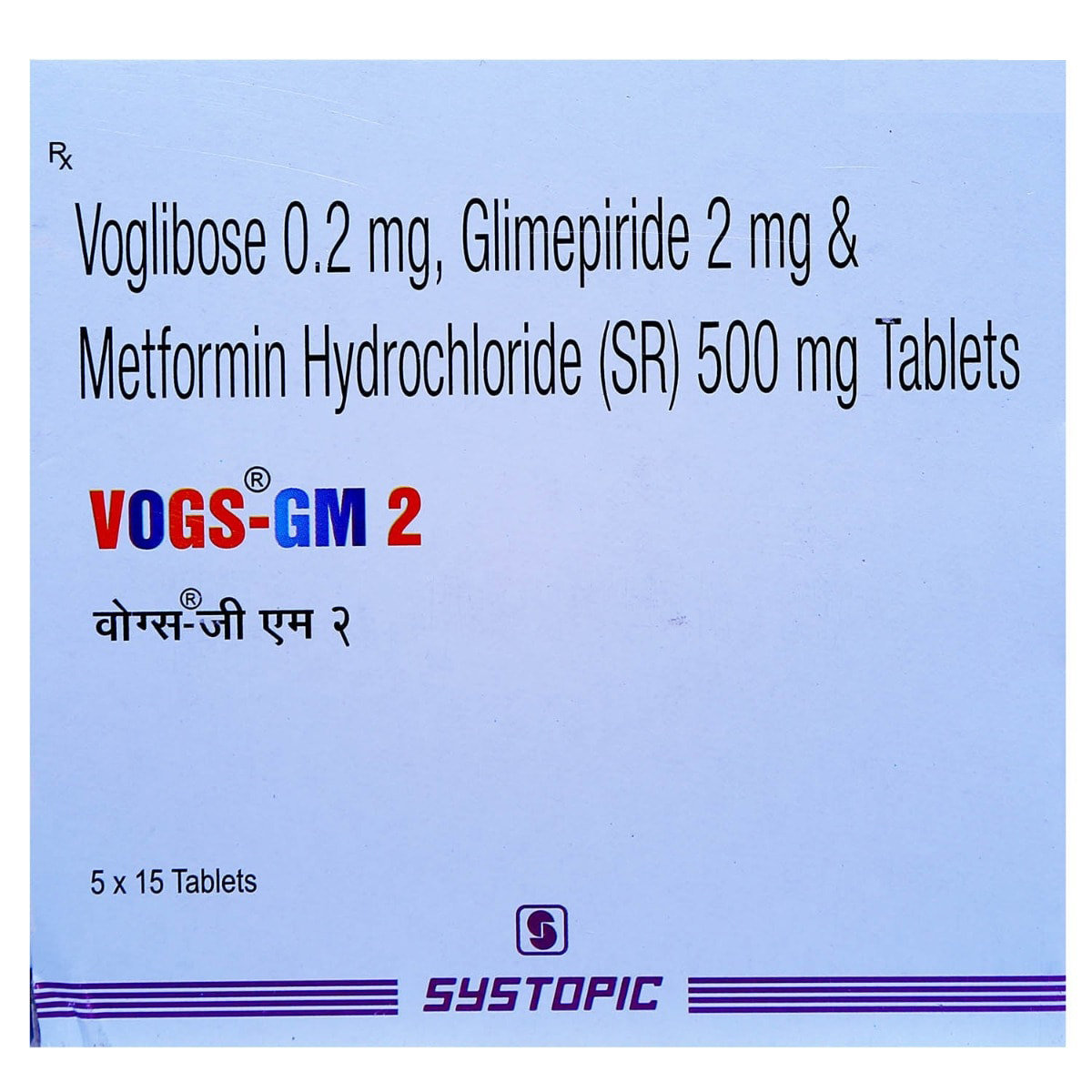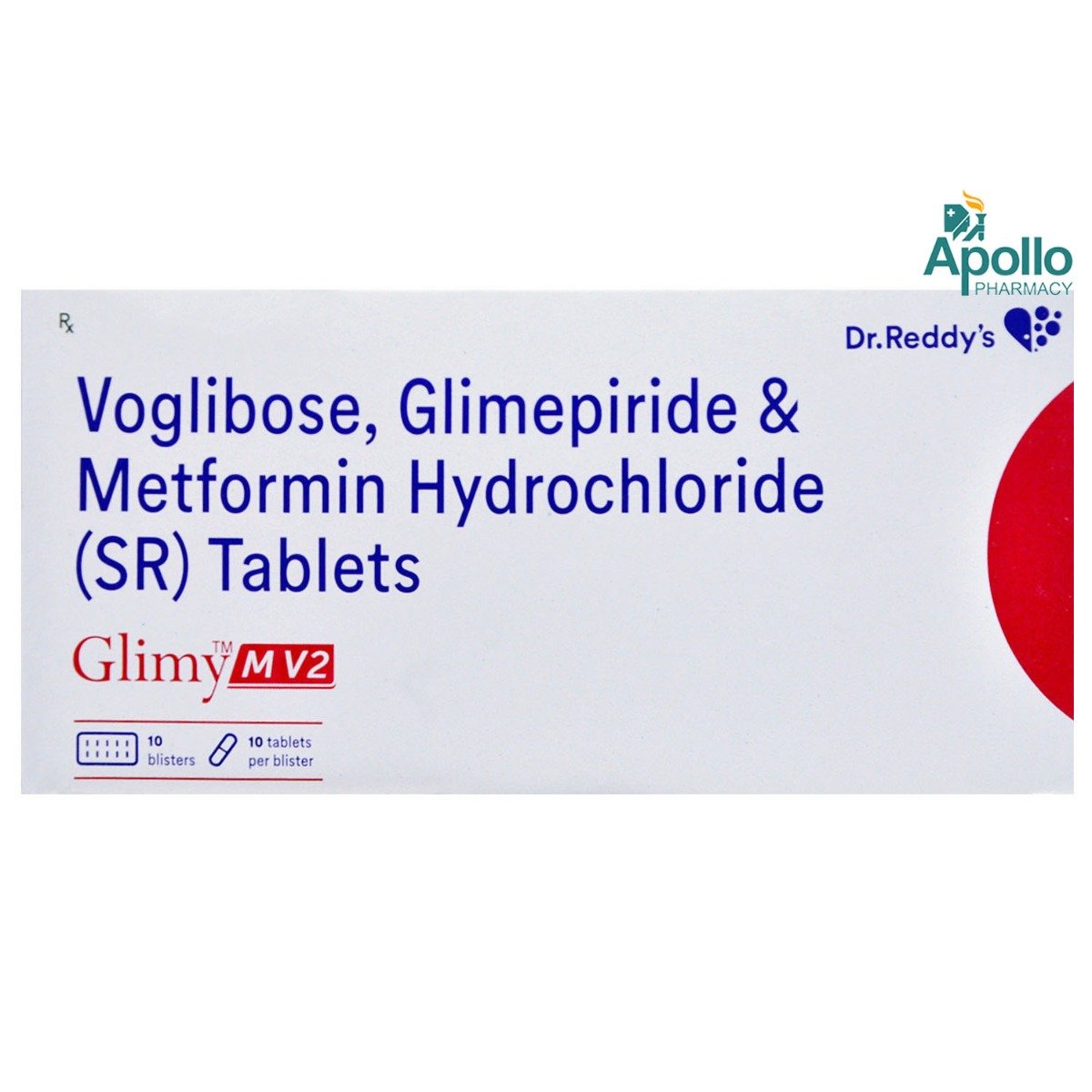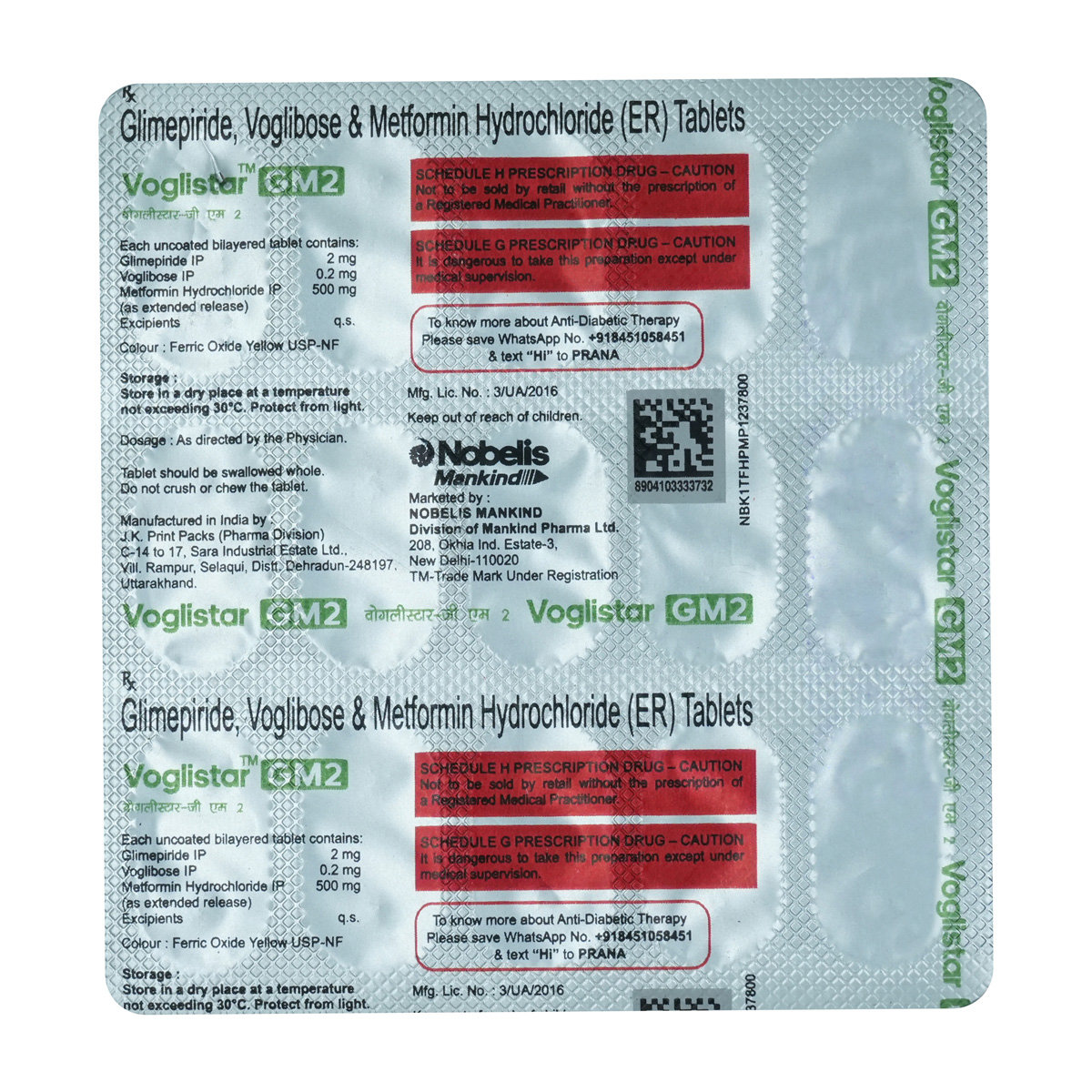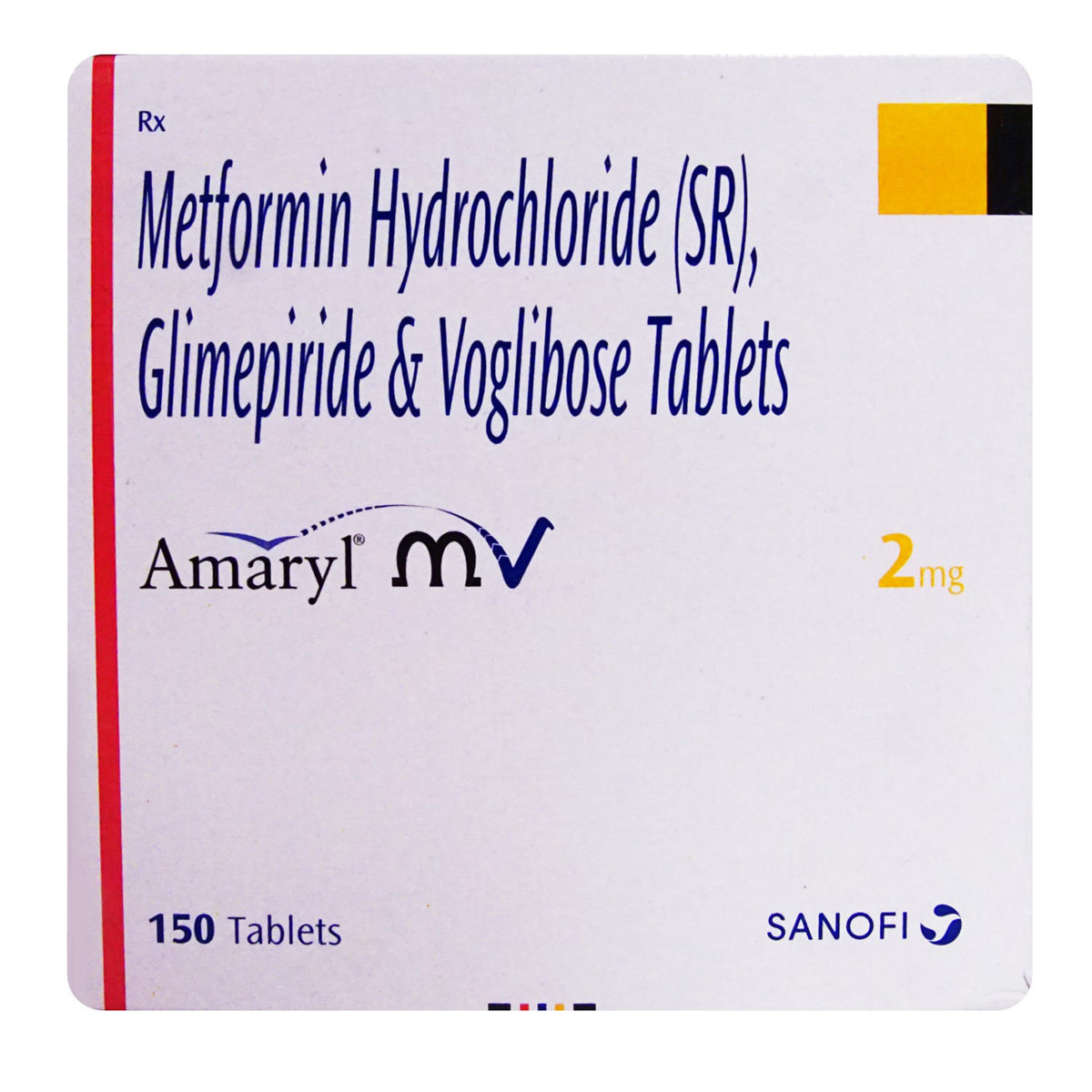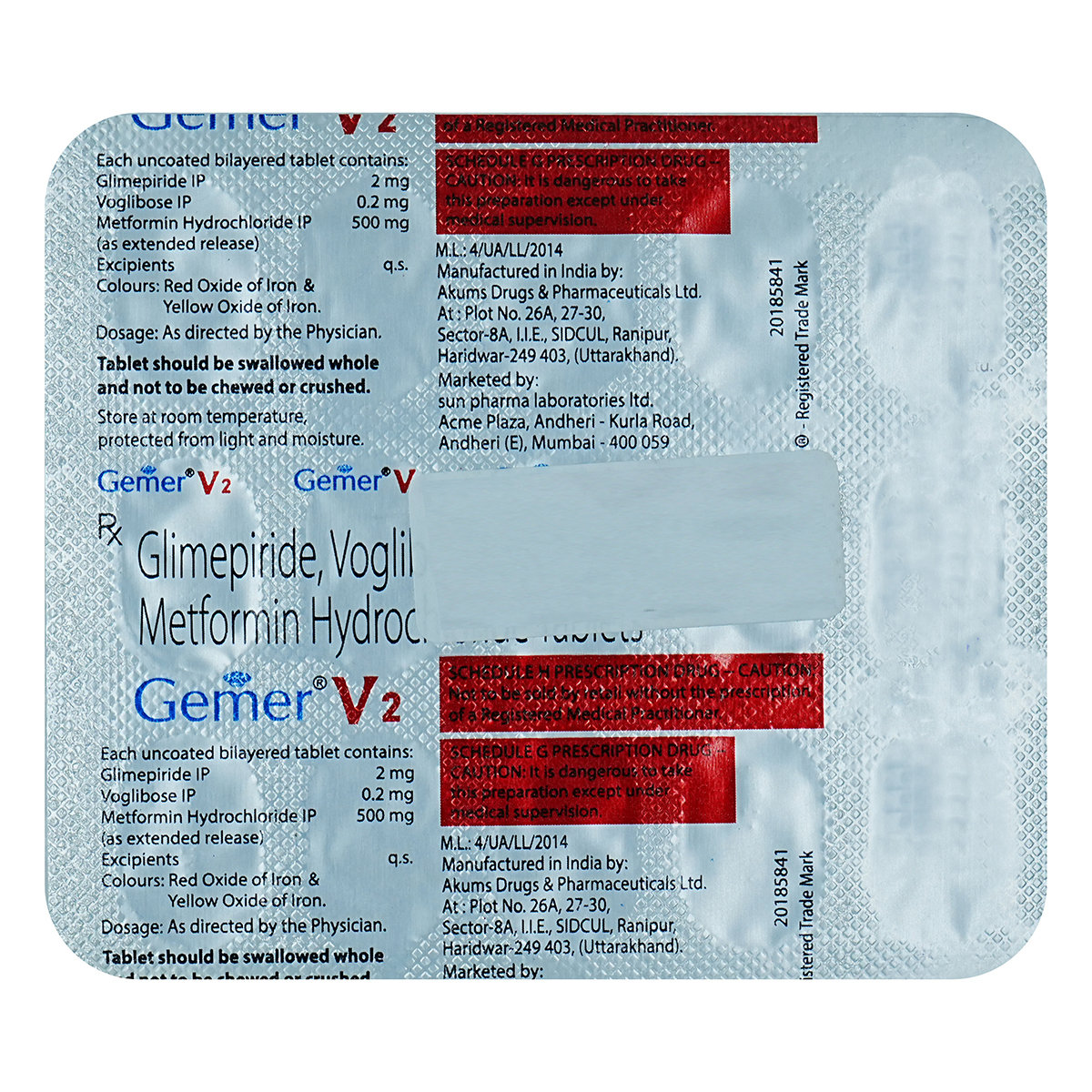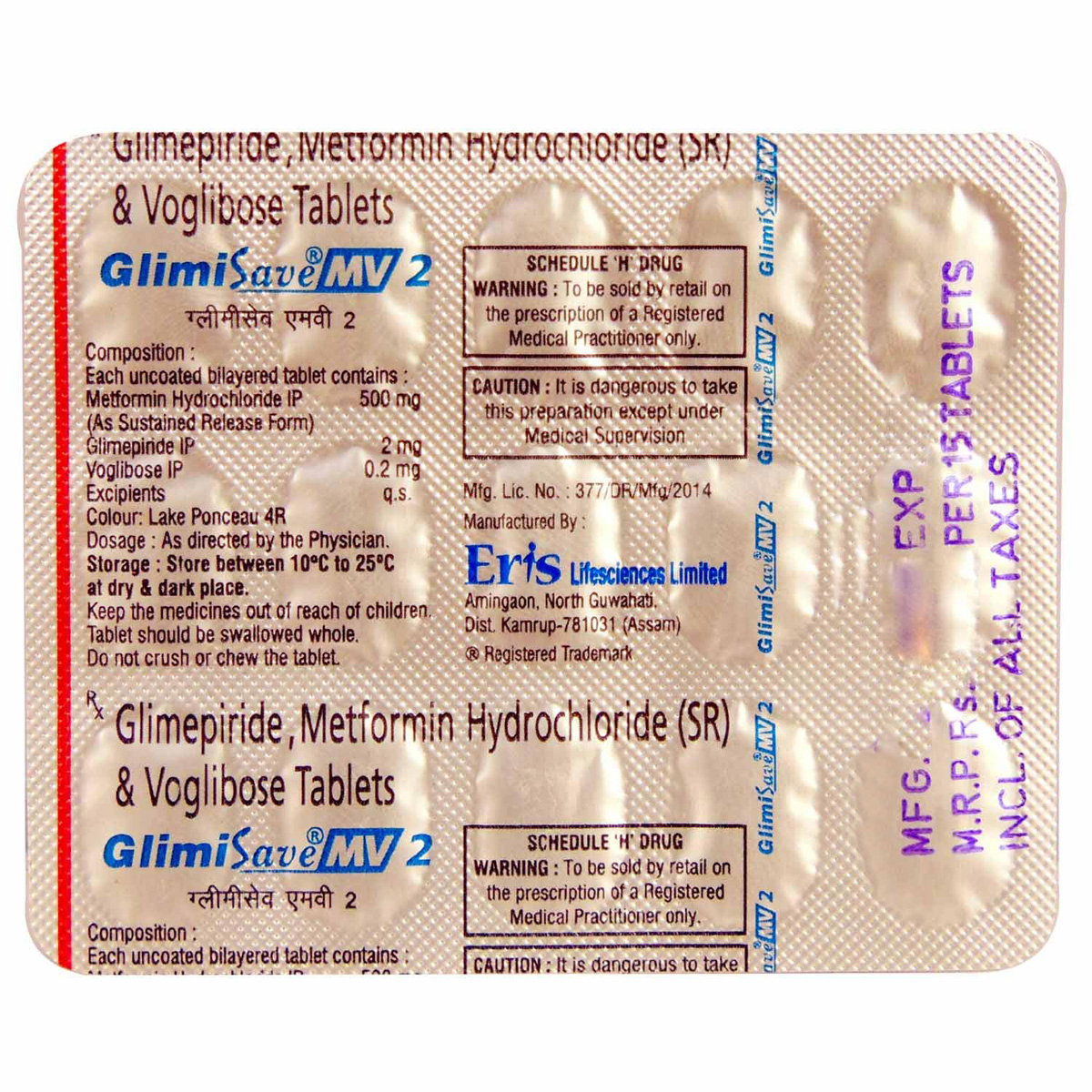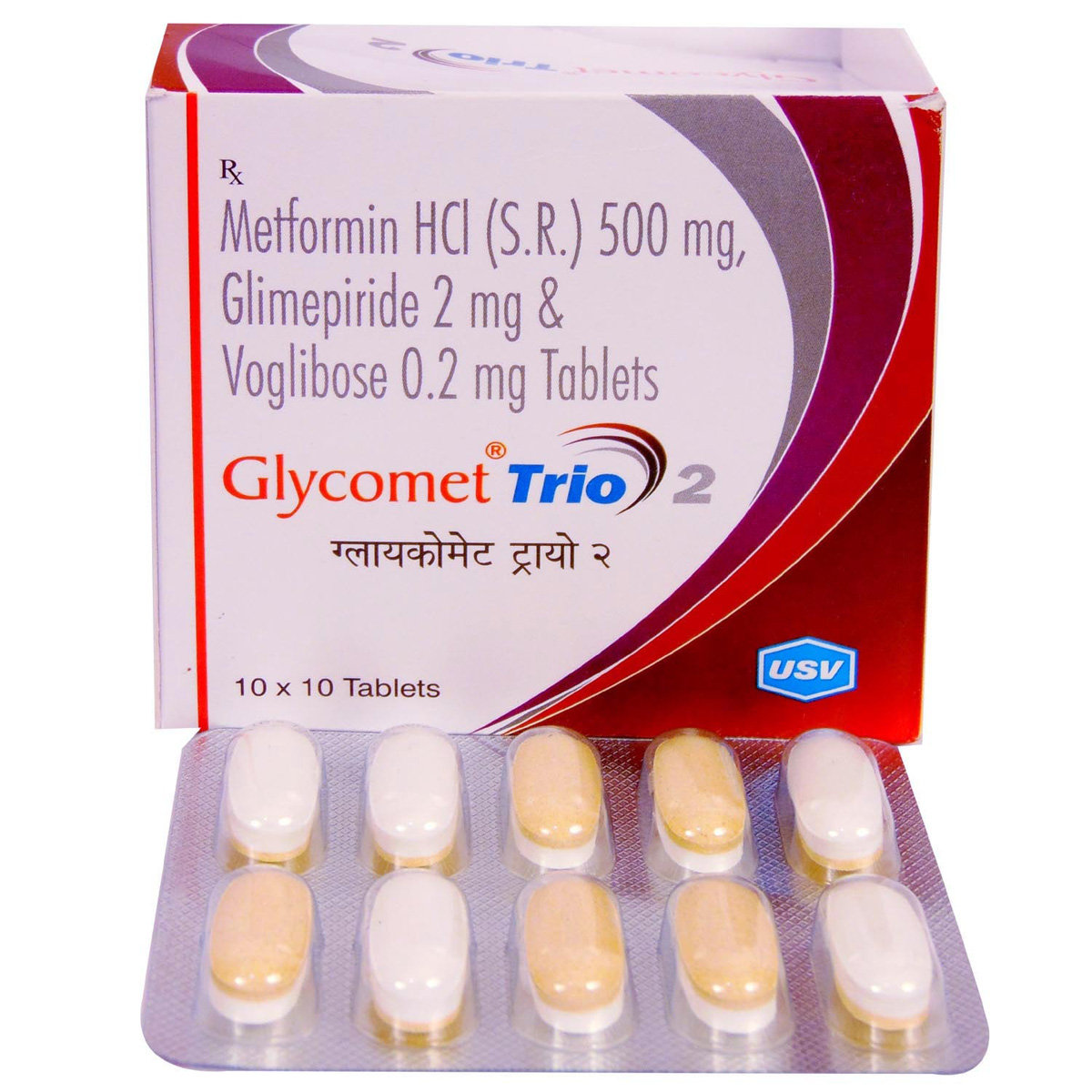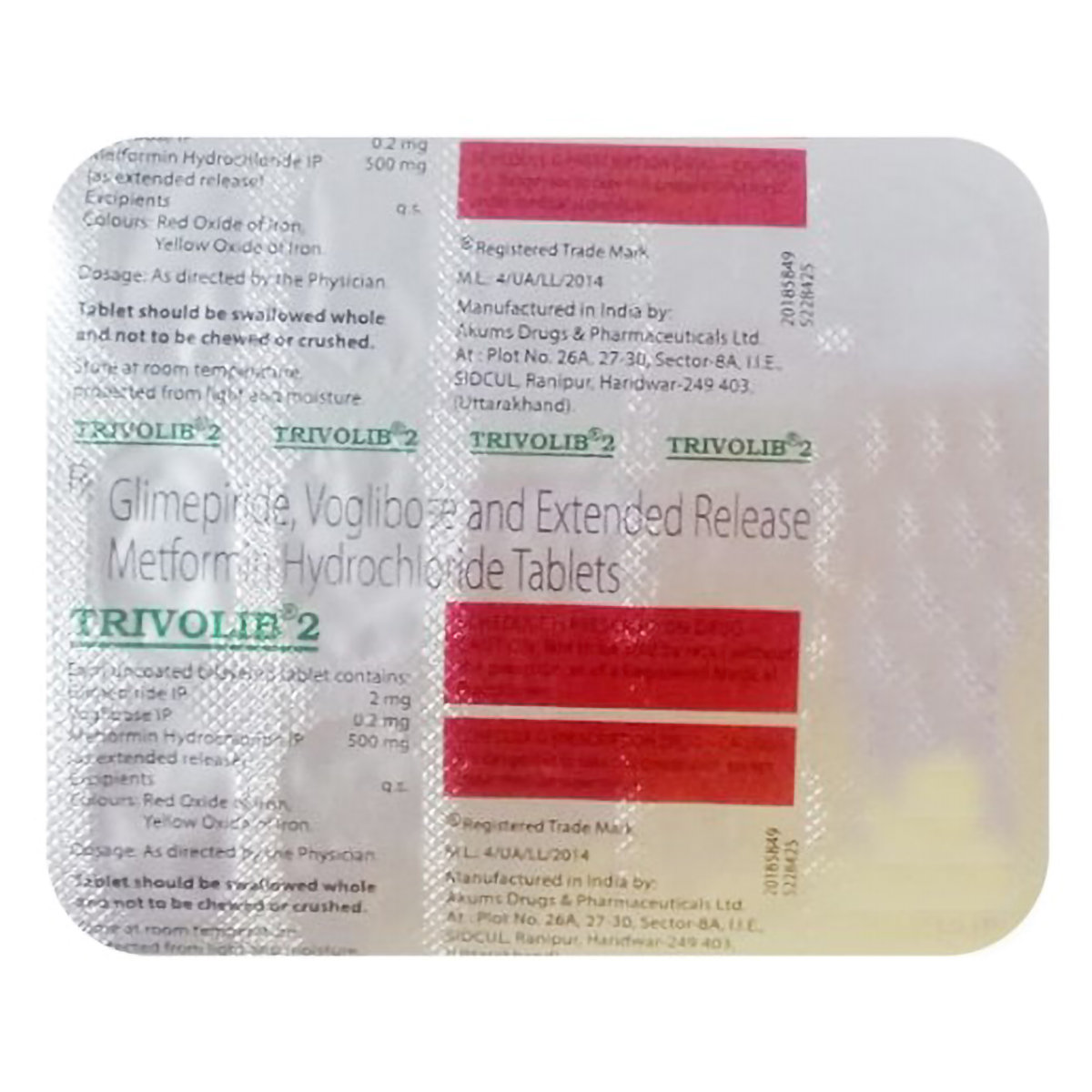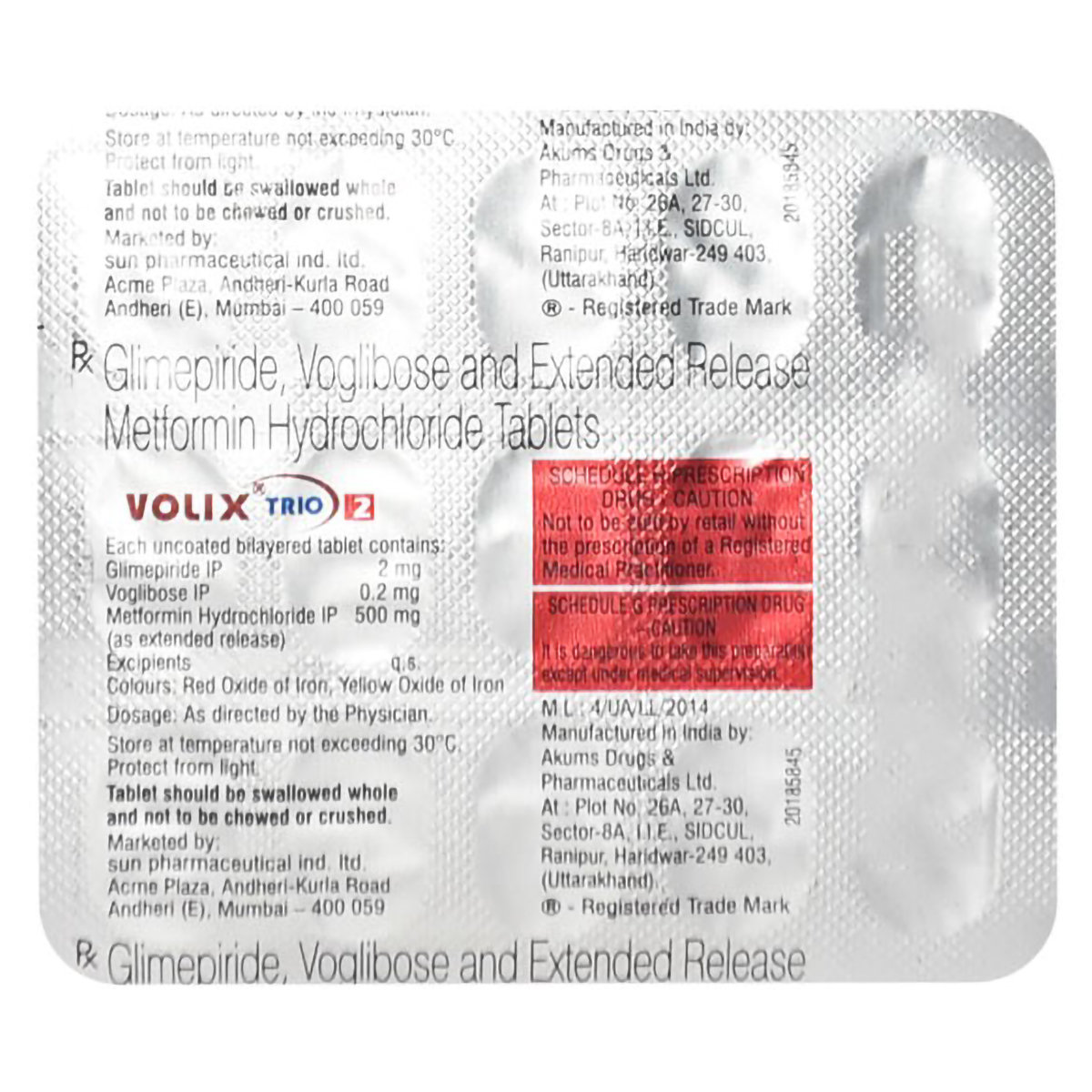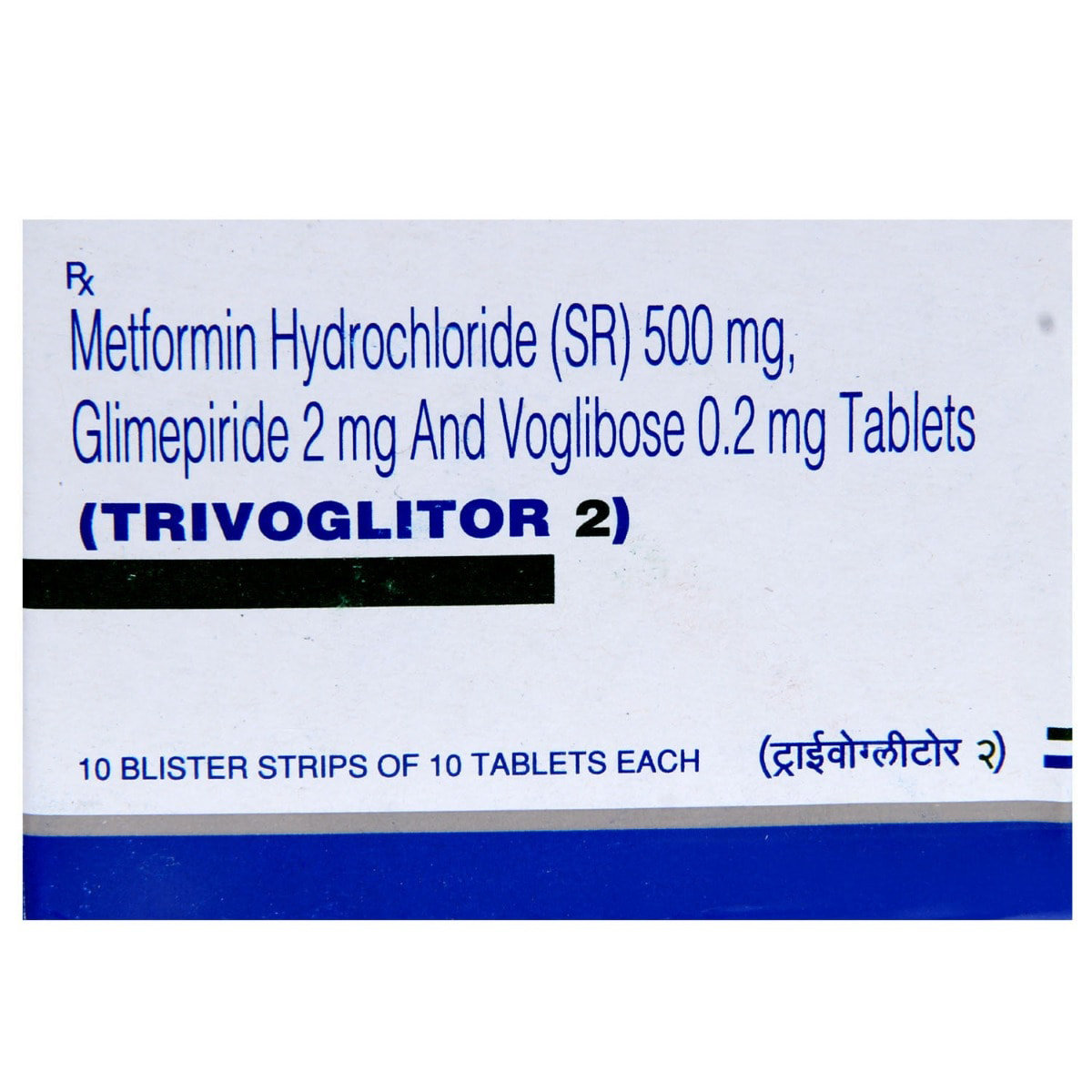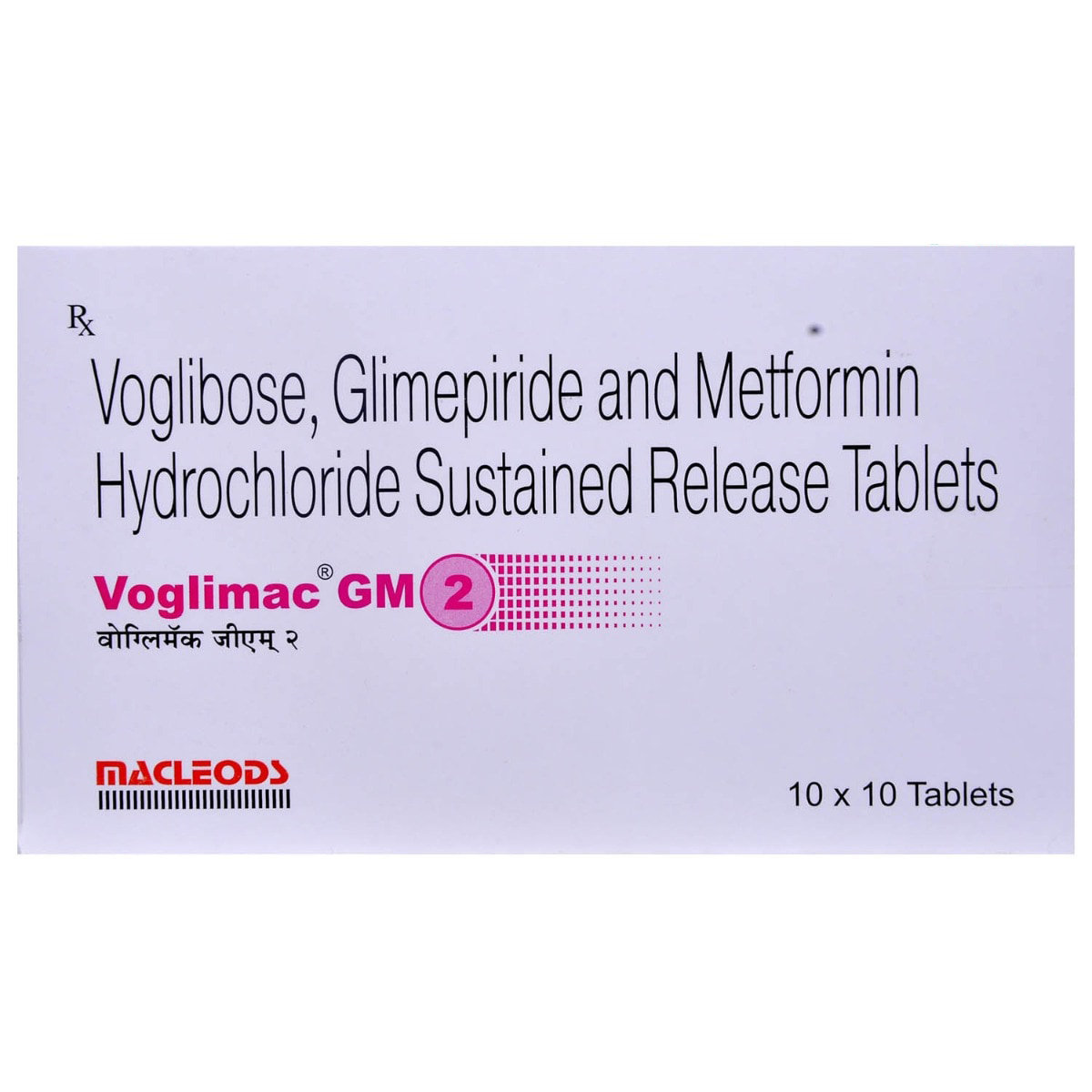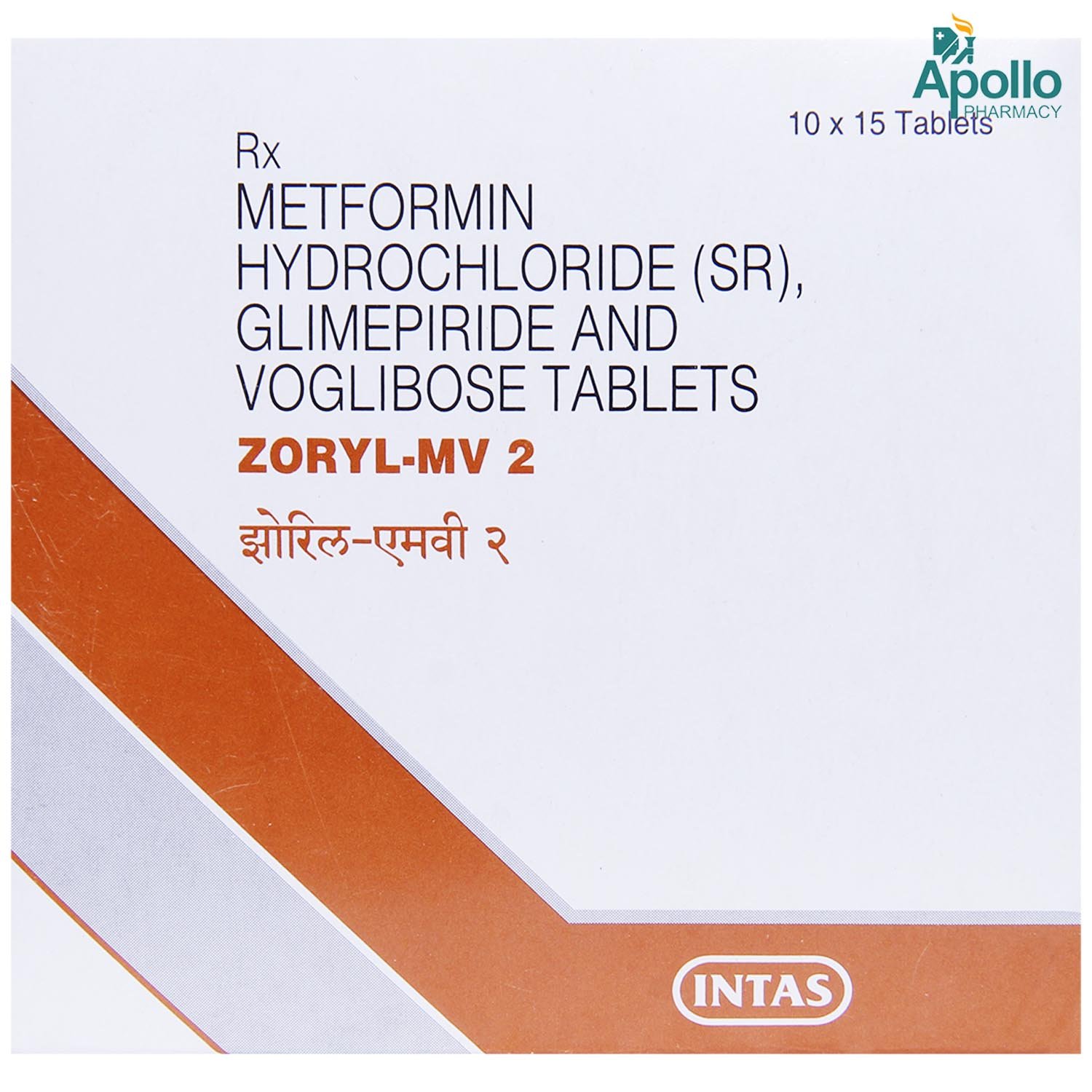Glyciphage VG2 Tablet 10's
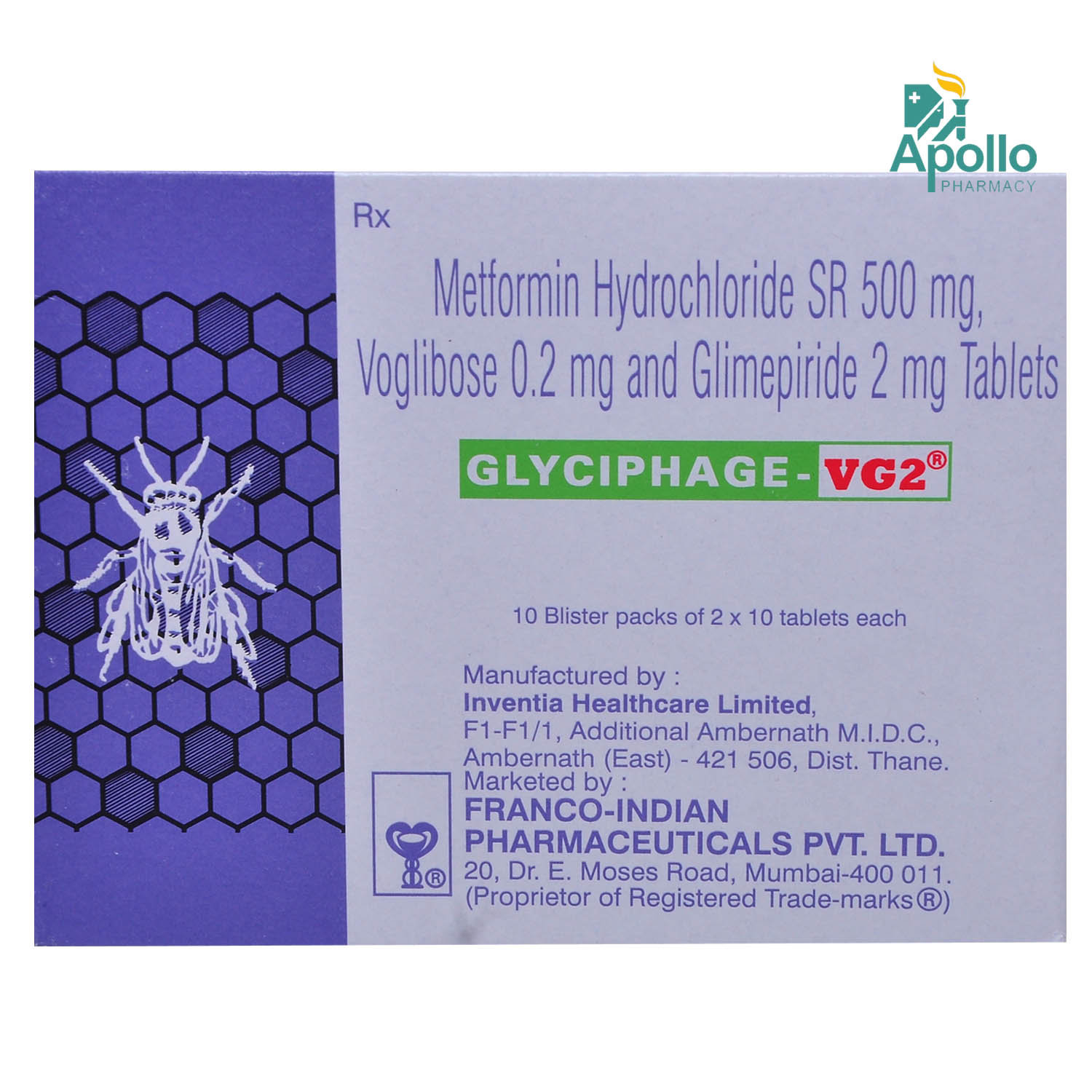
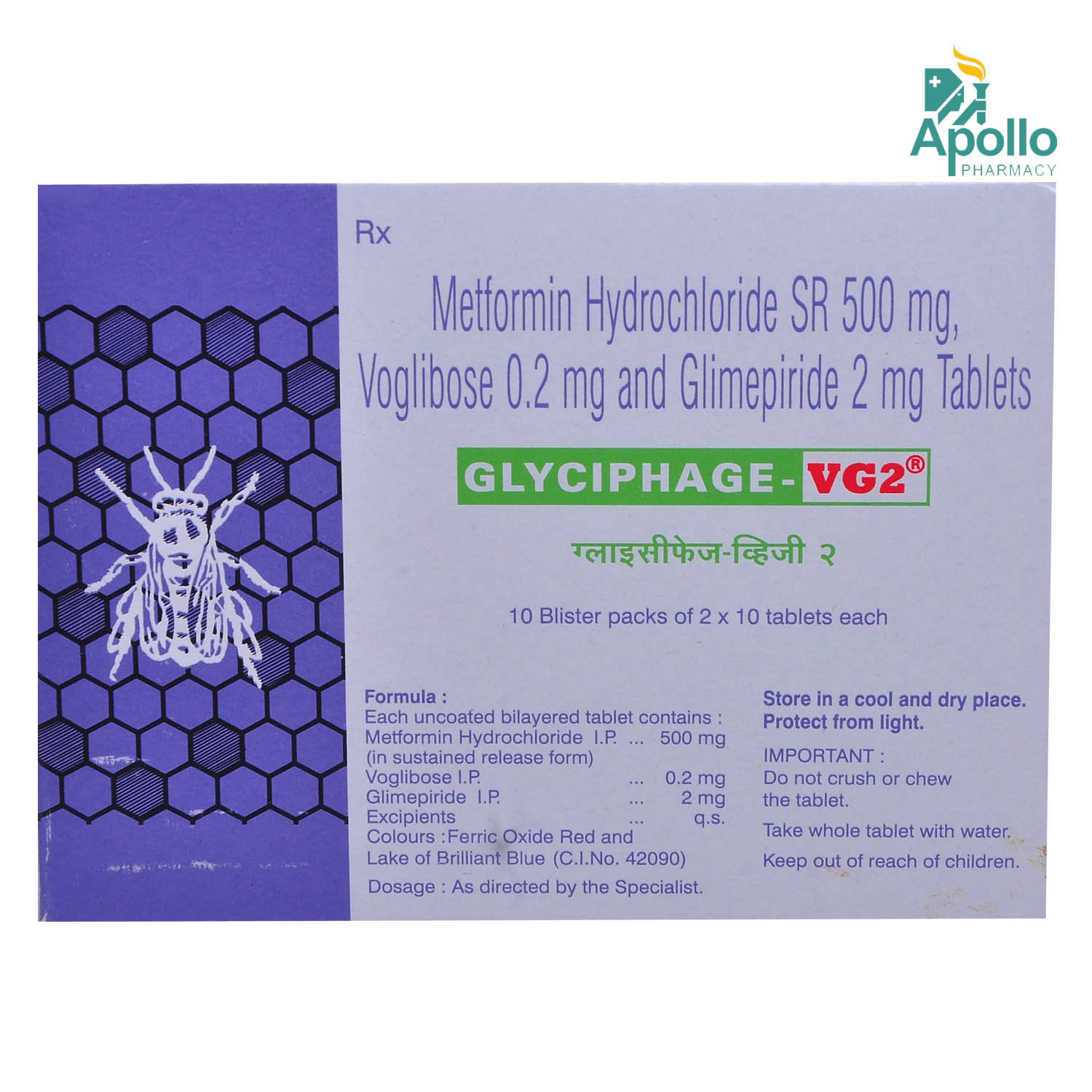
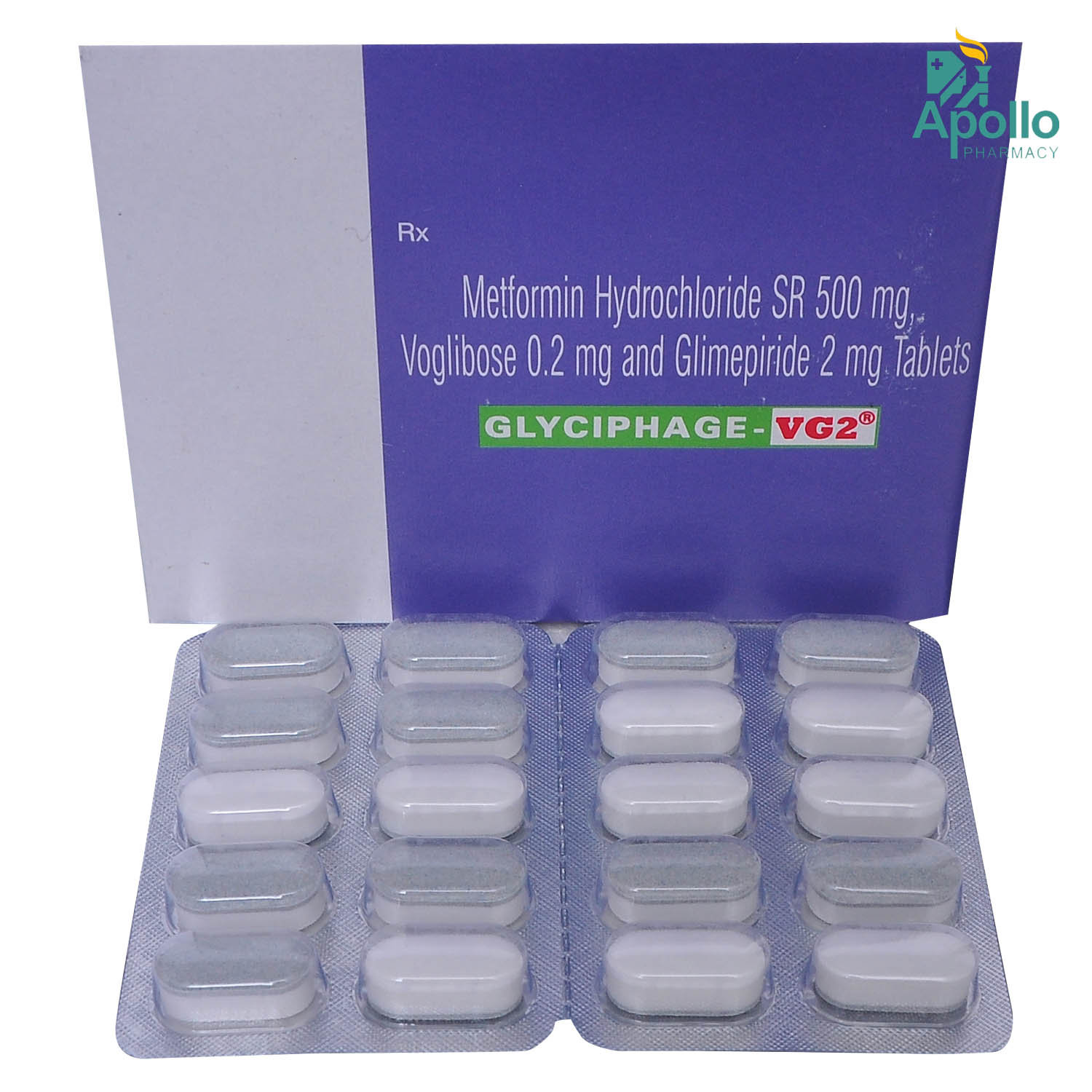
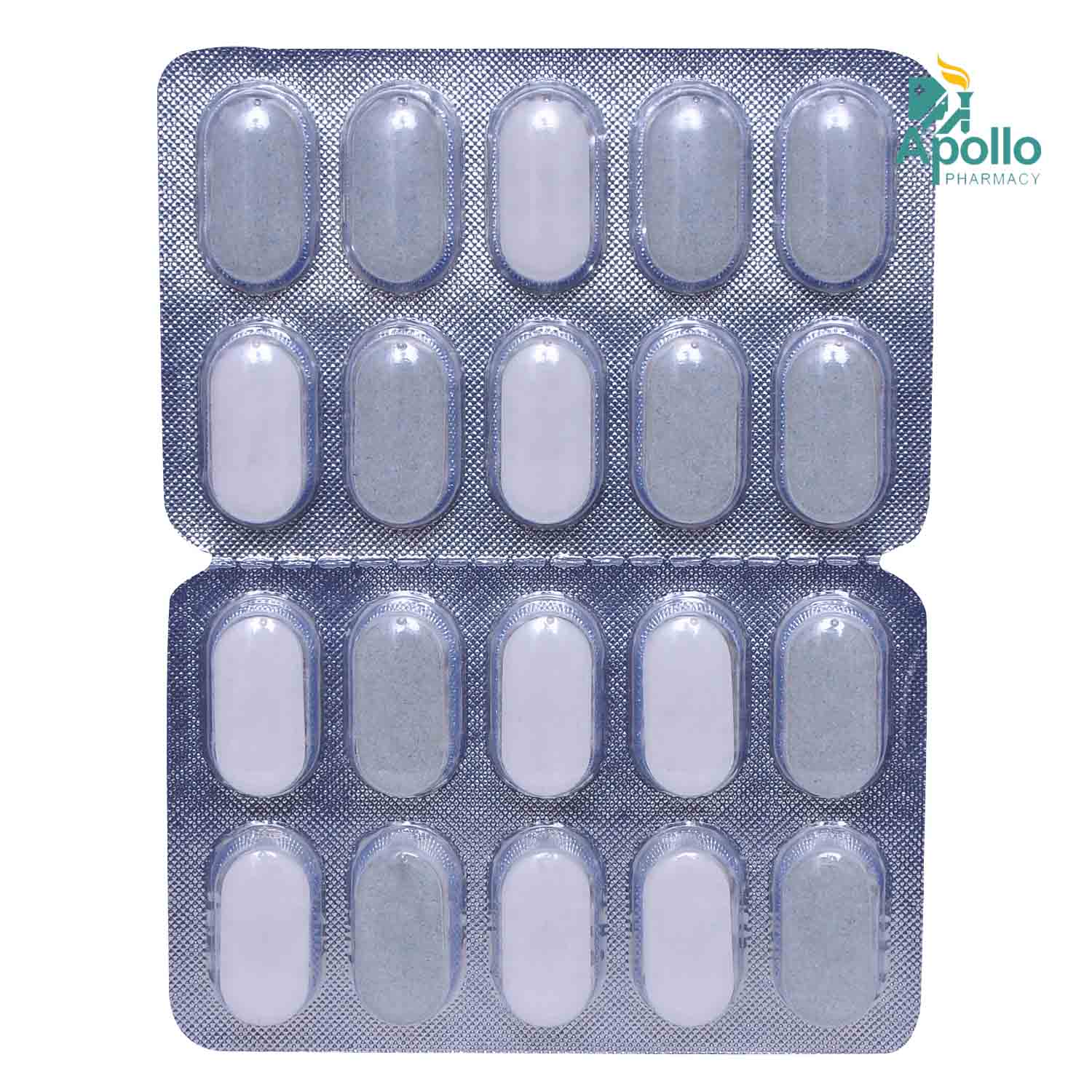
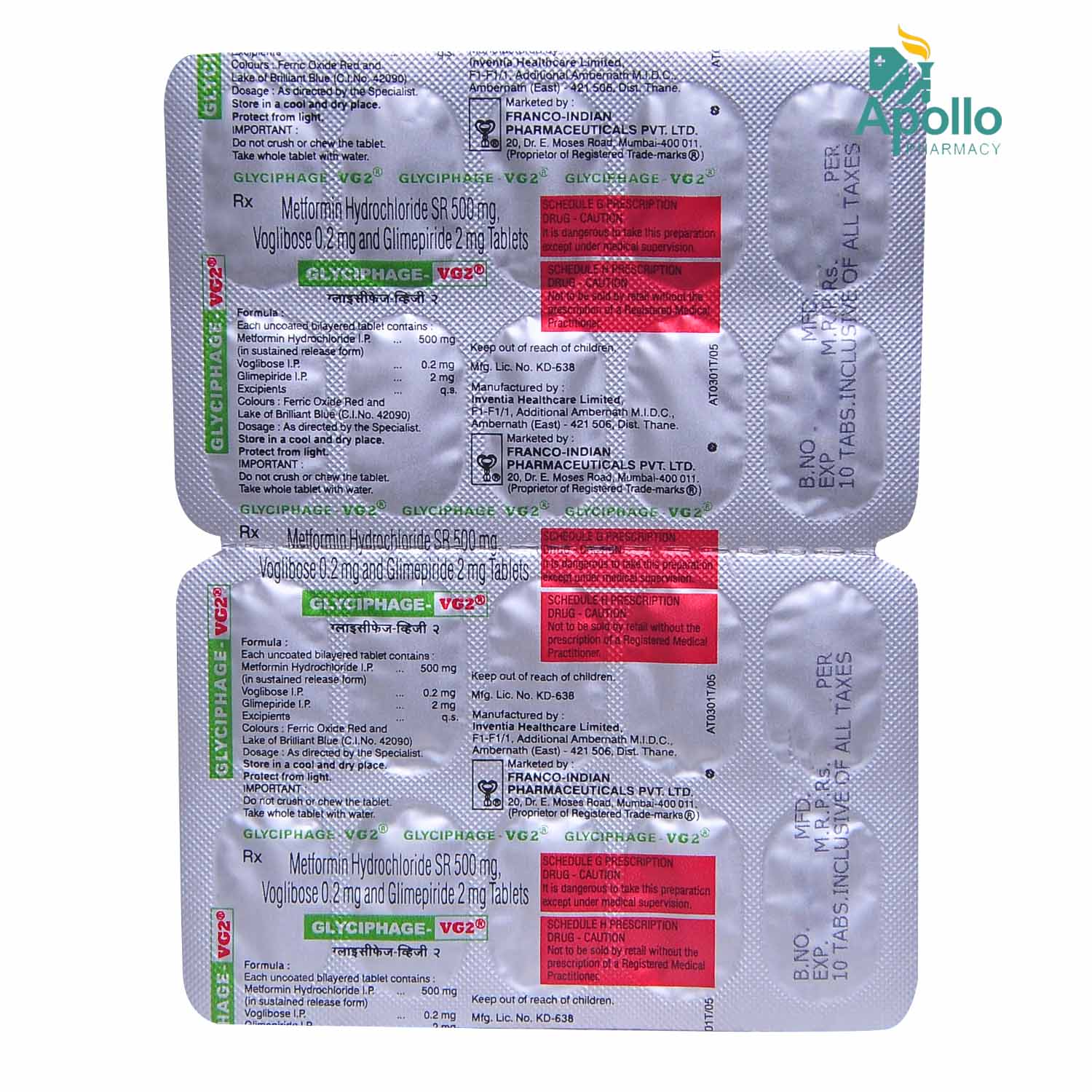





MRP ₹158.5
(Inclusive of all Taxes)
₹23.8 Cashback (15%)
Provide Delivery Location
Online payment accepted
 Prescription drug
Prescription drugWhats That
Synonym :
Composition :
Manufacturer/Marketer :
Consume Type :
Return Policy :
Expires on or after :
About Glyciphage VG2 Tablet
Glyciphage VG2 Tablet is a combination of anti-diabetic drugs used to treat type 2 diabetes mellites. Type 2 diabetes is a chronic or lifelong condition that affects the way your body processes glucose. People with type 2 diabetes either do not produce enough insulin or if at all the insulin is produced, it is unable to perform its function in the body (insulin resistance). Due to this, the blood glucose level increases and causes symptoms such as frequent urination, increased thirst and increased hunger start.
Glyciphage VG2 Tablet is a combination of three antidiabetic drugs: Glimepiride, Metformin and Voglibose. Glimepiride, which is a 'sulfonylurea', acts by increasing the amount of insulin released by the pancreas. Metformin, which is a 'biguanide', acts by lowering the glucose production in the liver, delaying glucose absorption from the intestines and increasing the body's response to insulin. Voglibose, which is an 'alpha-glucosidase inhibitor', prevents the breakdown of complex sugars into simple sugars such as glucose in the intestine. In a nutshell, the three medicines together prevent the blood glucose levels from rising to very high levels, thus keeping your diabetes under control.
Glyciphage VG2 Tablet should be taken with food to avoid an upset stomach. Based on your medical condition, your doctor will decide for how long you need to take Glyciphage VG2 Tablet . Glyciphage VG2 Tablet may cause certain common side effects such as hypoglycaemia (low blood glucose levels), taste change, nausea, diarrhoea, stomach pain, headache, upper respiratory symptoms. Most of these side effects do not require medical attention and will resolve gradually over time. However, if you experience these side effects persistently, consult your doctor.
Continue taking Glyciphage VG2 Tablet for as long as your doctor has advised. If you stop taking Glyciphage VG2 Tablet abruptly, it may increase your sugar levels which could further increase the risk of eyesight loss (retinopathy), kidney (nephropathy) and nerve damage (neuropathy). Glyciphage VG2 Tablet should not be taken if you have type 1 diabetes mellitus, severe kidney or liver disease. Please inform your doctor if you have any type of heart disease, are planning to get pregnant or are breastfeeding.
Uses of Glyciphage VG2 Tablet
Directions for Use
Medicinal Benefits
Glyciphage VG2 Tablet contains Glimepiride, Metformin and Voglibose. Glimepiride, which is a 'sulfonylurea', acts by increasing the amount of insulin released by the pancreas. Metformin, which is a 'biguanide', acts by lowering the glucose production in the liver, delaying glucose absorption from the intestines and increasing the body's response to insulin. Voglibose, which is an 'alpha-glucosidase inhibitor' prevents the breakdown of complex sugars into simple sugars such as glucose in the intestine. Glyciphage VG2 Tablet prevents the blood glucose levels from rising to very high levels thus keeping your diabetes under control. Glyciphage VG2 Tablet also helps to prevent serious complications of diabetes such as kidney damage (Diabetic Nephropathy), blindness (Diabetic Retinopathy), loss of sensation in your hands and feet (Diabetic Neuropathy), Glyciphage VG2 Tablet also helps to reduce your chance of having a heart attack or stroke. Being a combination of three drugs, Glyciphage VG2 Tablet reduces the need to take multiple pills and hence makes it easier to remember to take the drugs.
Storage
Drug Warnings
Some diabetic patients taking Glyciphage VG2 Tablet may develop a rare but serious condition called lactic acidosis. In this condition, there is too much lactic acid accumulated in the blood. So, your liver and kidney proper functioning is required for the elimination of excess lactic acid from the blood. You should not take Glyciphage VG2 Tablet if you have kidney disease, as measured by a blood test. Glyciphage VG2 Tablet may lower vitamin B12 levels, so try to have blood test annual blood and vitamin. Glyciphage VG2 Tablet when used with or without insulin has the tendency to extremely lower the blood sugar level. So, the doctor may lower the dose of insulin. Glyciphage VG2 Tablet may lower your thyroid-stimulating hormone (TSH), so an annual check-up of TSH is suggested.
Drug-Drug Interactions
Drug-Drug Interactions
Login/Sign Up
Co-administration of Glyciphage VG2 Tablet and Iodamide can increase the risk of lactic acidosis (when the body produces too much lactic acid).
How to manage the interaction:
Taking Glyciphage VG2 Tablet with Iodamide is generally avoided as it can result in an interaction, please consult your doctor before taking it.
Co-administration of Glyciphage VG2 Tablet and Iobenzamic acid can increase the risk of lactic acidosis (when the body produces too much lactic acid).
How to manage the interaction:
Taking Glyciphage VG2 Tablet with Iobenzamic acid is generally avoided as it can result in an interaction, please consult your doctor before taking it.
Co-administration of Glyciphage VG2 Tablet with Metrizamide together can cause the risk of lactic acidosis (when the body produces too much lactic acid ).
How to manage the interaction:
Taking Glyciphage VG2 Tablet with Metrizamide is generally avoided as it can possibly result in an interaction, it can be taken if a doctor has advised it. However, if you experience headaches, muscle cramps or pain, contact a doctor immediately. Do not discontinue any medications without consulting a doctor.
Co-administration of Iopydol with Glyciphage VG2 Tablet can increase the risk of side effects.
How to manage the interaction:
Taking Glyciphage VG2 Tablet with Iopydol is not recommended, please consult your doctor before taking it.
Co-administration of Glyciphage VG2 Tablet and Iocarmic acid can increase the risk of lactic acidosis (when the body produces too much lactic acid).
How to manage the interaction:
Taking Glyciphage VG2 Tablet with Iocarmic acid is generally avoided as it can result in an interaction. please consult your doctor before taking it.
Co-administration of Iodixanol with Glyciphage VG2 Tablet can increase the risk of side effects.
How to manage the interaction:
Taking Glyciphage VG2 Tablet with Iodixanol is not recommended, please consult a doctor before taking it. Do not discontinue the medications without consulting a doctor.
Co-administration of Glyciphage VG2 Tablet and Iobitridol can increase the risk of lactic acidosis (when the body produces too much lactic acid).
How to manage the interaction:
Taking Glyciphage VG2 Tablet with Iobitridol is generally avoided as it can result in an interaction. Please consult your doctor before taking it.
Co-administration of Ioversol with Glyciphage VG2 Tablet can increase the risk of side effects.
How to manage the interaction:
Taking Glyciphage VG2 Tablet with Ioversol is not recommended, please consult your doctor before taking it.
Co-administration of Iopamidol with Glyciphage VG2 Tablet can increase the risk of side effects.
How to manage the interaction:
Taking Glyciphage VG2 Tablet with Iopamidol is not recommended, please consult a doctor before taking it. Do not discontinue the medications without consulting a doctor.
Co-administration of Iotroxic acid with Glyciphage VG2 Tablet can increase the risk of side effects.
How to manage the interaction:
Taking Glyciphage VG2 Tablet with Iotroxic acid is not recommended, please consult your doctor before taking it.
Drug-Food Interactions
Drug-Food Interactions
Login/Sign Up
Diet & Lifestyle Advise
- Fill your half plate with starchy veggies, quarter with proteins and quarter with whole grain.
- Eat at regular interval. Do not take long gap between a meal or snack.
- Monitor your blood sugar level regularly especially when there are a lot of fluctuations.
- Invest at least 150 min of moderate intensity physical activity and 15 minutes of high intensity exercise every week.
- Lose weight gradually to achieve a healthy body mass index (18.5 to 24.9).
- Replace refined carbohydrates containing foods with wholegrain foods and increase intake of fruits and veggies and other fibre enriched foods.
- Reduce intake of saturated fat (or hidden fats) in the food like chips, crisps, pastries, biscuits and samosas. Choose omega 3 fatty acid containing oils for daily cooking. For frying, you may use palm oil, mustard oil, groundnut oil, rice bran oil and safflower oil.
- Do not take stress as it may elevate your blood sugar level. You may adopt stress management techniques like mindfulness, yoga or meditation to control stress related blood sugar changes.
- Opt for low-fat dairy products (low fat yogurt, fat free milk and cheese etc.).
- Keep your blood pressure as normal (120/80) as possible. As it reduces risk of cardiovascular diseases in diabetes patients.
Side Effects of Glyciphage VG2 Tablet
- Hypoglycaemia (low blood glucose level)
- Taste change
- Nausea
- Diarrhoea
- Stomach pain
- Flatulence
- Headache
- Upper respiratory symptoms
Habit Forming
Therapeutic Class
All Substitutes & Brand Comparisons
RX
Vogs-GM 2 Tablet 15's
Systopic Laboratories Pvt Ltd
₹125
(₹7.5 per unit)
47% CHEAPERRX
Glimy M V 2 Tablet 10's
Dr Reddy's Laboratories Ltd
₹174.5
(₹15.71 per unit)
10% COSTLIERRX
Voglistar GM2 Tablet 15's
Mankind Pharma Pvt Ltd
₹262.5
(₹15.75 per unit)
10% COSTLIER
Product Substitutes
Drug-Diseases Interactions
Drug-Diseases Interactions
Login/Sign Up
FAQs
If you have symptoms like increased hunger, increased thirst, frequent urination (usually at night), unexplained weight loss, fatigue, blurred vision, slow wound/sores healing and frequent infections, contact doctor as it can be a condition of type 2 diabetes.
Hypoglycaemia refers to low blood sugar levels. The symptoms of hypoglycaemia include nausea, headache, irritability, hunger, sweating, dizziness. Glyciphage VG2 Tablet can cause hypoglycaemia. Hypoglycaemia can occur if you miss or delay your food, drink alcohol, over-exercise or take other anti-diabetic medicine along with Glyciphage VG2 Tablet . Diabetics are advised to keep a quick source of sugar like glucose tablets, honey or fruit juice with them.
Glyciphage VG2 Tablet should be avoided in patients who are allergic to any of the components or excipients of this medicine. It should be avoided in patients suffering from moderate to severe kidney disease and in patients with underlying metabolic acidosis including diabetic ketoacidosis.
If you feel thirsty after taking Glyciphage VG2 Tablet , it may be because of dehydration as Glyciphage VG2 Tablet can lead to loss of fluids. Increase intake of fluids, if even then you feel thirsty please consult your doctor.
If you have been affected with diabetes, you should have a test of HbA1c once in three months.
Yes, long-term usage of Glyciphage VG2 Tablet can cause vitamin B12 deficiency as it interferes with the absorption of vitamin B12 in the stomach. The symptoms can be managed by taking Vitamin B12 supplements as advised by your doctor.
No. Till date there is no clinical evidence that states that Glyciphage VG2 Tablet affects fertility in either men or women.
Lactic acidosis is rare but life threatening condition when, there is too much of lactic acid build up in the bloodstream. Long term intake of Glyciphage VG2 Tablet may lead to lactic acidosis when cells get deprived of the oxygen levels. Symptoms of lactic acidoisis includes burning sensation of muscle, muscle ache, fast breathing, nausea and stomach pain. Immediately contact doctor if you experience any of these symptoms when on Glyciphage VG2 Tablet .
In case you feel that your blood sugar level is going down and you are feeling weak, immediately eat sugar candies or drink sugar beverages. It will help to balance blood sugar level in your body. So, it is advisable to keep sugar candies with you and consult a doctor immediately.
Drug-Drug Interactions Checker List
- HYDROCHLOROTHIAZIDE
- FUROSEMIDE
- AMLODIPINE
- DIGOXIN
- PREDNISOLONE
- METOPROLOL
Special Advise
- Keep taking the drug even if you think your blood sugar levels are under control. If you miss a dose, do not take a larger dose, consult your treating physician for advice.
- Take short frequent meals, avoid prolonged fasting when taking this drug. Beware of symptoms of hypoglycaemia which include sweating, dizziness, palpitations, shivering, intense thirst, dry mouth, dry skin, frequent urination etc. Whenever you experience the above mentioned symptoms, immediately consume 5-6 candies or 3 glucose biscuits or 3 teaspoons of honey/sugar and also get in touch with your physician. Make sure to carry these with you at all times, especially for long travels.
- It is always better that your physician knows about any underlying conditions like kidney disease or liver disease, prior heart attack, alcohol intake, etc before the doctor prescribes you this medicine.
- Avoid drinking alcohol while on this drug as it increases the risk of hypoglycaemia (decrease in blood sugar which might be fatal in some cases) and lactic acidosis (when the lactic acid increases in the body which impacts the functioning of various organs in the body).
- Try to quit smoking and reduce intake of carbohydrate rich food like potato, rice, mangoes, bread, sugar etc.
- Remember, lifestyle modifications are the most important step in controlling blood sugar levels.
Disease/Condition Glossary
Diabetes Mellitus type 2 is a condition in which either the body stops producing enough insulin (the hormone which helps to decrease sugar levels in the blood) or there is resistance to the action of insulin. As a result, excessive insulin is produced but it fails to act on the organs of the body. Symptoms of type 2 diabetes include feeling exhausted all time, feeling thirsty, having blurry vision, and urge to urinate (pee) more often. Complications of type 2 diabetes include skin infection, eye problems (retinopathy), nerve damage (neuropathy), diabetic foot (foot ulcer), kidney disease (nephropathy), high blood pressure and even stroke.

Have a query?
Buy best Diabetics products by
Torrent Pharmaceuticals Ltd
Sun Pharmaceutical Industries Ltd
Eris Life Sciences Ltd
Intas Pharmaceuticals Ltd
Lupin Ltd
Micro Labs Ltd
Mankind Pharma Pvt Ltd
Lloyd Healthcare Pvt Ltd
Alkem Laboratories Ltd
Abbott India Ltd
Glenmark Pharmaceuticals Ltd
Cipla Ltd
Macleods Pharmaceuticals Ltd
Wockhardt Ltd
Dr Reddy's Laboratories Ltd
Primus Remedies Pvt Ltd
USV Pvt Ltd
Aristo Pharmaceuticals Pvt Ltd
Emcure Pharmaceuticals Ltd
Alembic Pharmaceuticals Ltd
Ipca Laboratories Ltd
La Renon Healthcare Pvt Ltd
Ajanta Pharma Ltd
Medley Pharmaceuticals Ltd
East West Pharma India Pvt Ltd
Elbrit Life Sciences Pvt Ltd
Corona Remedies Pvt Ltd
Hbc Life Sciences Pvt Ltd
Sinsan Pharmaceuticals Pvt Ltd
Ranmarc Labs
Mitoch Pharma Pvt Ltd
Zydus Healthcare Ltd
Sanofi India Ltd
Akumentis Healthcare Ltd
Fusion Health Care Pvt Ltd
Unison Pharmaceuticals Pvt Ltd
Jubilant Lifesciences Ltd
Novo Nordisk India Pvt Ltd
Tas Med India Pvt Ltd
Blue Cross Laboratories Pvt Ltd
Msn Laboratories Pvt Ltd
Eswar Therapeutics Pvt Ltd
Indoco Remedies Ltd
Q Check Pharmaceuticals
Alteus Biogenics Pvt Ltd
Anthem Bio Pharma
Franco Indian Pharmaceuticals Pvt Ltd
Systopic Laboratories Pvt Ltd
Panacea Biotec Ltd
Zydus Cadila
Biocon Ltd
Edoc Life Sciences Pvt Ltd
Koye Pharmaceuticals Pvt Ltd
Arkas Pharma Pvt Ltd
Diacardus Pharmacy Pvt Ltd
Elinor Pharmaceuticals (P) Ltd
Remedy Life Sciences Pvt Ltd
Saan Labs
Talent India Pvt Ltd
Jarun Pharmaceuticals Pvt Ltd
Capital Pharma
Shrrishti Health Care Products Pvt Ltd
FDC Ltd
Leeford Healthcare Ltd
Nirvana India Pvt Ltd
Elder Pharmaceuticals Ltd
Eli Lilly and Company (India) Pvt Ltd
Glynis Pharmaceuticals Pvt Ltd
Zuventus Healthcare Ltd
Arrient Healthcare Pvt Ltd
Cadomed Pharmaceuticals India Pvt Ltd
Orris Pharmaceuticals
Akesiss Pharma Pvt Ltd
Bal Pharma Ltd
Biochem Pharmaceutical Industries Ltd
Knoll Healthcare Pvt Ltd
Lippon Pharma Pvt Ltd
Morepen Laboratories Ltd
Neucure Lifesciences Pvt Ltd
Opsis Care Lifesciences Pvt Ltd
Wallace Pharmaceuticals Pvt Ltd
Acmedix Pharma Llp
Converge Biotech Pvt Ltd
Erinyle Pharma
Indiabulls Pharmaceuticals Pvt Ltd
Ozone Pharmaceuticals Ltd
Retra Life Science Pvt Ltd
Alvio Pharmaceuticals Pvt Ltd
Geneaid Pharmaceuticals
Heal (India) Laboratories Pvt Ltd
Olcare Laboratories Pvt Ltd
Vasu Organics Pvt Ltd
Kotak Life Sciences
Lakshya Life Sciences Pvt Ltd
Proqol Health Care Pvt Ltd
Sanz Pharmaceuticals
Daylon healthcare pvt Ltd
Mcronus Lifescience Pvt Ltd
Natco Pharma Ltd
Orsim Pharma
Alcohol
Unsafe
Taking Glyciphage VG2 Tablet with alcohol can cause hypoglycaemia and can also lead to a rare but life-threatening condition known as Lactic Acidosis. So, keep your doctor informed if you drink alcohol.
Pregnancy
Caution
As the data around the use of Glyciphage VG2 Tablet in pregnant women is limited, the use of Glyciphage VG2 Tablet in pregnancy is restricted. It is highly recommended to consult your doctor before taking this drug in case you are pregnant.
Breast Feeding
Caution
The name is not recommended during breastfeeding. However, your doctor may prescribe it for you during breastfeeding if he/she feels that the benefit to you outweighs the risk. You should not take Glyciphage VG2 Tablet without a doctor's advice.
Driving
Caution
Glyciphage VG2 Tablet may cause hypoglycaemia (low blood sugar levels) whose symptoms include unusual sleepiness, shivering, palpitations, sweating etc. This may affect your ability to drive. Use caution while driving or doing anything that requires concentration.
Liver
Caution
Glyciphage VG2 Tablet to be taken with caution, especially if you have a history of liver diseases/conditions. Dose may have to be adjusted by your doctor depending on your liver function tests.
Kidney
Caution
Glyciphage VG2 Tablet to be taken with caution, especially if you have a history of Kidney diseases/conditions. Dose may have to be adjusted by your doctor depending on your kidney function tests.
Children
Caution
Glyciphage VG2 Tablet is not recommended for children below the age of 18 years. The safety and effectiveness of Glyciphage VG2 Tablet has not been established in children due to limited evidence. So, only take Glyciphage VG2 Tablet if the doctor has prescribed Glyciphage VG2 Tablet .
Recommended for a 30-day course: 3 Strips


